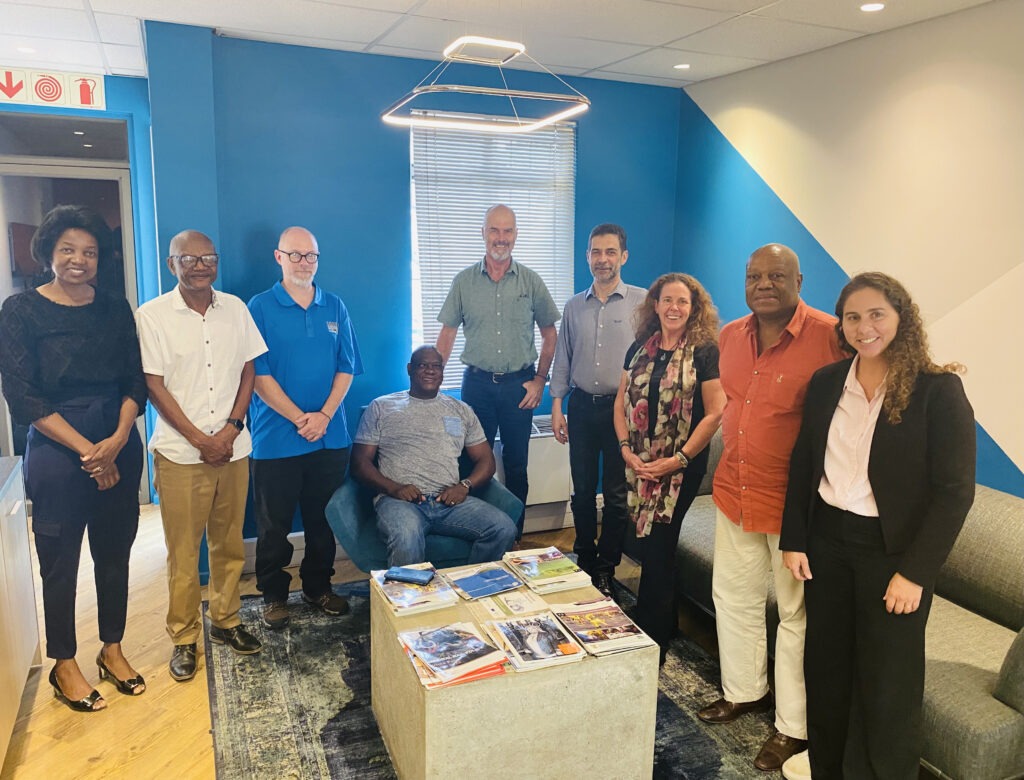By Mariangel Garcia
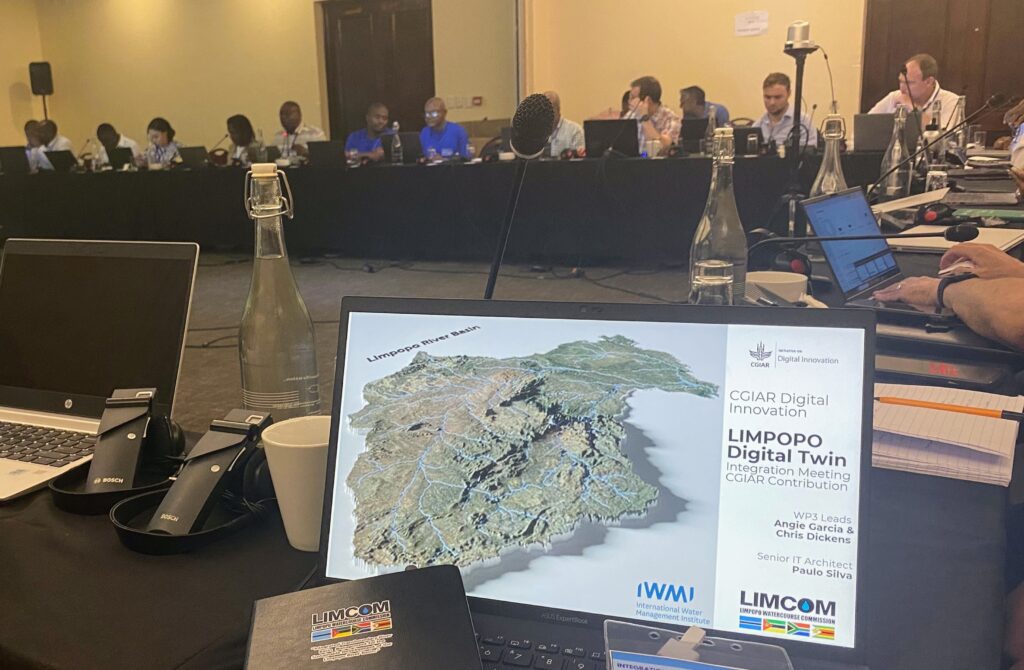
The Limpopo Watercourse Commission (LIMCOM), in collaboration with the Global Water Partnership Southern Africa (GWPSA), successfully concluded a two-day integration workshop for the United Nations Development Program-Global Environment Fund (UNDP-GEF) Limpopo project on February 7-8, 2024, in Pretoria, South Africa. The workshop marked a significant milestone in the journey towards the implementation of the project “Integrated Transboundary River Basin Management for the Sustainable Development of the Limpopo River Basin,” which aims to uplift the living standards of its population and conserve the basin’s resources and ecosystem services.
The workshop brought together over 50 participants including LIMCOM member states, partners, consultants, and the project management team. The event facilitated a comprehensive dialogue among technical partners of the UNDP-GEF Limpopo project, fostering awareness of the interconnected roles within the project, especially in the development of the Limpopo Transboundary Diagnostic Analysis (TDA) and Strategic Action Plan (SAP).
UNDP, together with the GWPSA, is supporting the project, funded by the GEF. As the GEF implementing entity, the UNDP provides overall oversight of the project with GWPSA being the executing agency, while LIMCOM is the focal custodian of the project implementation.
The CGIAR’s International Water Management Institute (IWMI) under the Digital Innovation Initiative shared the innovative concept of a digital twin for river basin management. A digital twin is a digital representation of a physical object, person, or process, contextualized in a digital version of its environment. Digital twins can help an organization simulate real situations and their outcomes, ultimately allowing it to make better decisions.
This digital twin prototype represents a game-changer for the Limpopo River Basin, offering unprecedented potential for collaboration within the UNDP-GEF project and among LIMCOM’s riparian countries. It exemplifies the cutting-edge solutions being developed to tackle the complex challenges of integrated, cross-sectoral, and ecosystem-based river basin management.
The IWMI team was inspired by the innovative approaches and significant contributions presented during the workshop, reinforcing the impactful role the UNDP-GEF project is set to play.
“It was truly remarkable to witness the collective commitment and groundbreaking strategies aimed at the sustainable development of the Limpopo River Basin,” said Mariangel Garcia, CGIAR Digital Innovation Work Package 3 Lead, developing the digital twin project for the Limpopo. “We were deeply grateful for the opportunity to contribute to such a crucial initiative and are excited to assist in steering the Limpopo Basin towards becoming a benchmark of success in river basin management.”
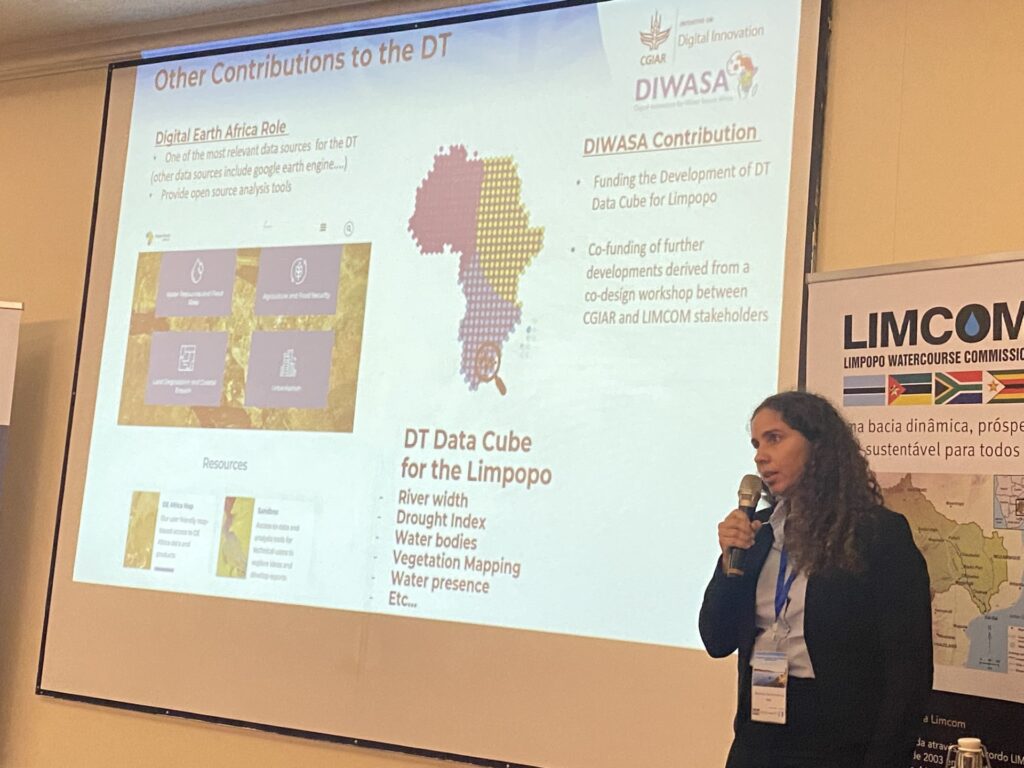
CGIAR Digital Innovation contribution to the Limpopo Basin
CGIAR-IWMI has made a significant contribution to enhancing research for water resource management and river basin management through a combination of scientific products, the development of a digital twin, and leveraging citizen science. These efforts are aimed at providing sustainable solutions for the Limpopo Basin, incorporating advanced technology and community involvement to address complex challenges.
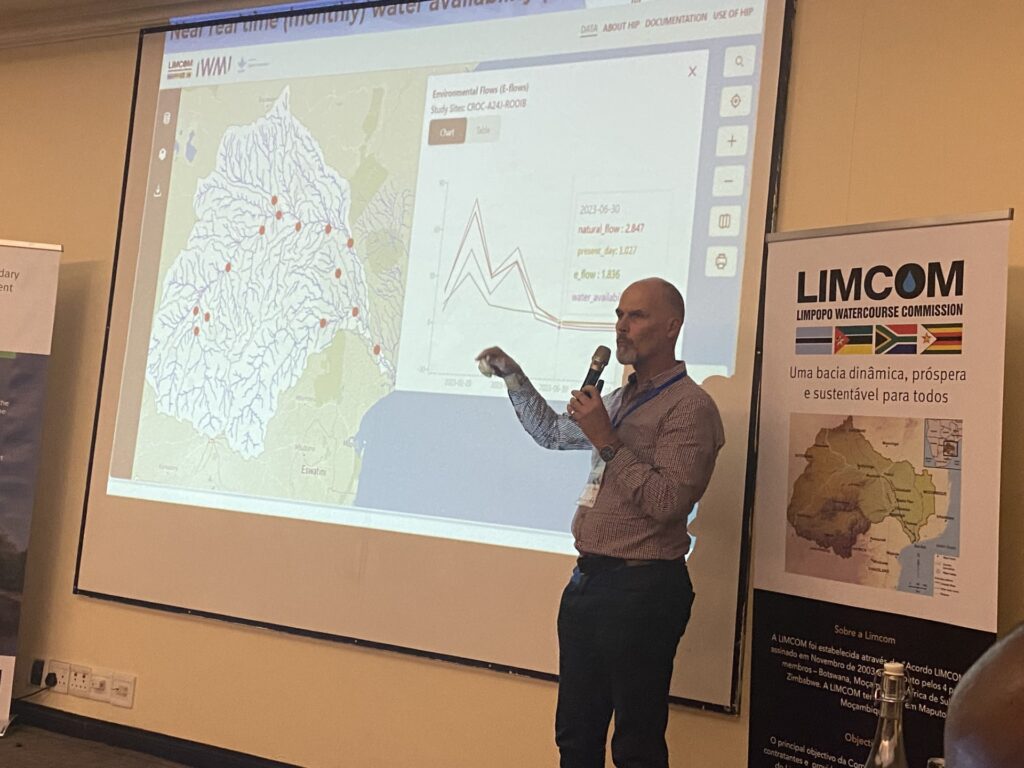
Scientific innovations provide critical insights into water dynamics
CGIAR’s scientific advancements include the development of a near real-time basin hydrological model, providing critical insights into water dynamics across the Limpopo Basin. Additionally, seasonal water availability forecasts offer valuable predictions for planning and management purposes. The operationalization of environmental flows (E-flows) and digital assessments thereof ensure that water distribution supports both human and ecological needs. Moreover, CGIAR has innovated in agricultural water management with near real-time irrigation mapping, enhancing irrigation efficiency and supporting sustainable agriculture practices.
“The development of digital twins for river basin management represents perhaps the biggest opportunity to advance sustainable management that we have seen for decades. A digital twin for a river basin will bring together large amounts of near real-time data and complex models in a way that is simple to understand so that basin management becomes more effective and much simpler,” said Chris Dickens, CGIAR Digital Innovation Work Package 3 Co-lead.
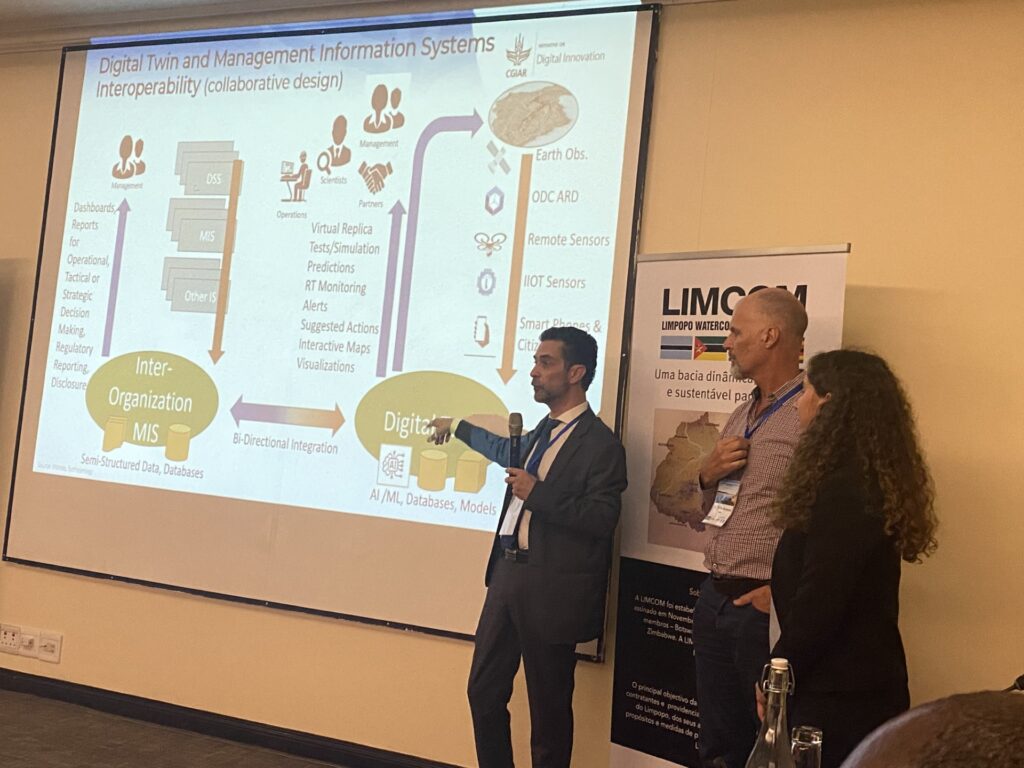
The digital twin fosters innovation and collaboration
The development of a digital twin for the Limpopo represents a groundbreaking step towards integrated river basin management. This digital replica of the Limpopo Basin allows for real-time monitoring and simulation, offering a dynamic tool for decision-making and scenario planning. The co-design process involved in its development ensures that the digital twin is tailored to meet the specific needs and challenges of the Limpopo Basin, envisioning a sustainable and resilient future.
“A river basin such as Limpopo can be seen as a vast and complex system of systems, monitored and managed using multiple information systems and a variety of data sources, presenting several opportunities to foster innovation, data consolidation and vastly improved monitoring capabilities and more effective and timely decisions and actions with profound socioeconomic impacts,” said Paulo Silva, Senior IT Architect. “Applying the digital twin concept and adapting it to the specific characteristics and constraints of this type of environment is a challenge that motivates both scientific and IT communities and is therefore a pleasure and an honor to be part of such an undertaking.”
Citizens empowered to contribute towards science
CGIAR-IWMI presented and highlighted the invaluable role of community involvement in water resource management through its citizen science initiatives. These projects empower local communities to contribute to data collection and monitoring, enhancing the understanding of water resources and promoting a participatory approach to basin management. Under the digital innovation initiative there are two applications for citizen science monitoring of water systems such as the mini stream assessment scoring system, miniSASS and Enviro-Champs both already making impact in the basin and supported by UNICEF under the YOMA Platform to provide capacity building to thousands of youths who live in the basin.
DIWASA support for the Limpopo digital twin
Digital Innovation for a Water Secure Africa’s (DIWASA) support to the Limpopo digital twin has been pivotal, marking a significant milestone in the project’s development. Thanks to the generous backing from The Leona M. and Harry B. Helmsley Charitable Trust it will be possible to create the first datacube for the Limpopo Basin that will guarantee a sustainable data infrastructure open to all.
Digital Earth Africa significantly amplifies the impact of the digital twin initiative for the Limpopo Basin through its critical role in data provision and developmental support. This partnership extends beyond data sharing to include the development of a specialized datacube for the Limpopo, which integrates key metrics such as river width, drought indices, water bodies, vegetation mapping, and water presence among others. This tool offers an unparalleled depth of analysis and insight, facilitating more nuanced decision-making and management strategies.
Moreover, DIWASA’s commitment to fostering innovation and collaboration is evidenced by its co-funding of advancements stemming from a co-design workshop involving CGIAR and LIMCOM stakeholders. This financial support not only underpins the technical development of the digital twin, but also ensures that the project remains aligned with the needs and priorities of the Limpopo Basin’s management and its communities. By providing both open-source analysis tools and crucial funding, Digital Earth Africa plays an indispensable role in advancing the digital twin project, making a tangible difference in the sustainable management, and understanding of the Limpopo River Basin.
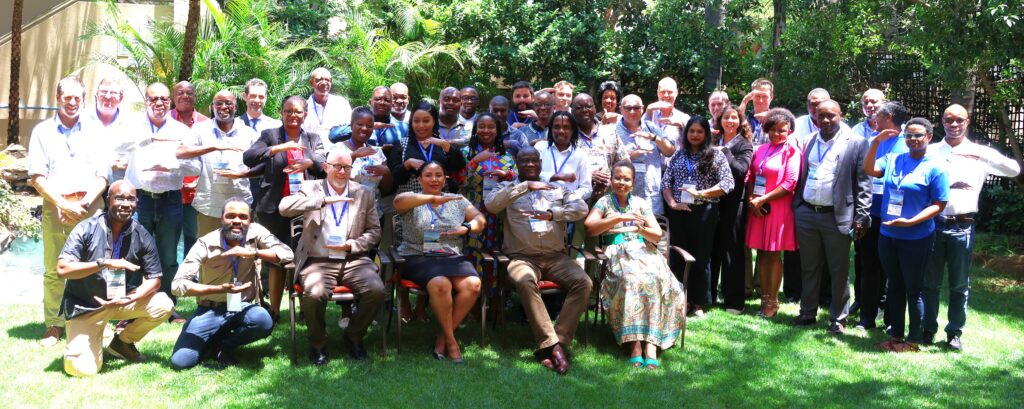
Key takeaways from the workshop from CGIAR-IWMI and UNDP-GEF
After the workshop a strategy alignment took place at the Pegasys head office, designed to align the plans of the GEF and CGIAR.
- The GEF project and CGIAR-IWMI’s digital twin initiative are set to advance in tandem, offering a comprehensive strategy for managing the Limpopo River Basin. This collaboration emphasizes the integration of efforts across flood management, sediment control, and groundwater management, with a focus on optimizing resource use for enhanced capacity building. CGIAR-IWMI plans to make significant inputs to the Limpopo Information Management System (LIMIS) through digital twin plugins, water availability forecasts, and irrigation mapping, and in this way aims to substantially augment the basin’s data capabilities. Additionally, the value of citizen science has been recognized, highlighting the need for high-quality, reliable data to uphold the standards set by the overseeing committee. This multifaceted approach promises to improve intervention efficiency and impact, steering the Limpopo Basin towards more sustainable management practices.
Next Steps:
- IWMI will collaborate with LIMCOM and partners to refine the digital twin effort, including strategic meetings to discuss integration with existing models and management strategies.
- Plans are in place for further collaboration and knowledge sharing with project stakeholders, including Pegasys for infrastructure discussions and LIMCOM for co-design goals.
- Continuous dialogue to ensure alignment with communication protocols and data requests, ensuring the digital twin’s development remains informed and relevant to stakeholder needs.
- The workshop not only showcased the groundbreaking work underway but also solidified the commitment of all involved to transforming the Limpopo Basin into a model of sustainable river basin management. The integration of digital innovations, such as the digital twin, alongside traditional management practices, sets a precedent for future projects worldwide.
This collaborative event laid the groundwork for a series of actions designed to bring about tangible improvements in the management of the Limpopo River Basin, emphasizing the importance of innovative solutions and partnerships in achieving sustainable development goals.
